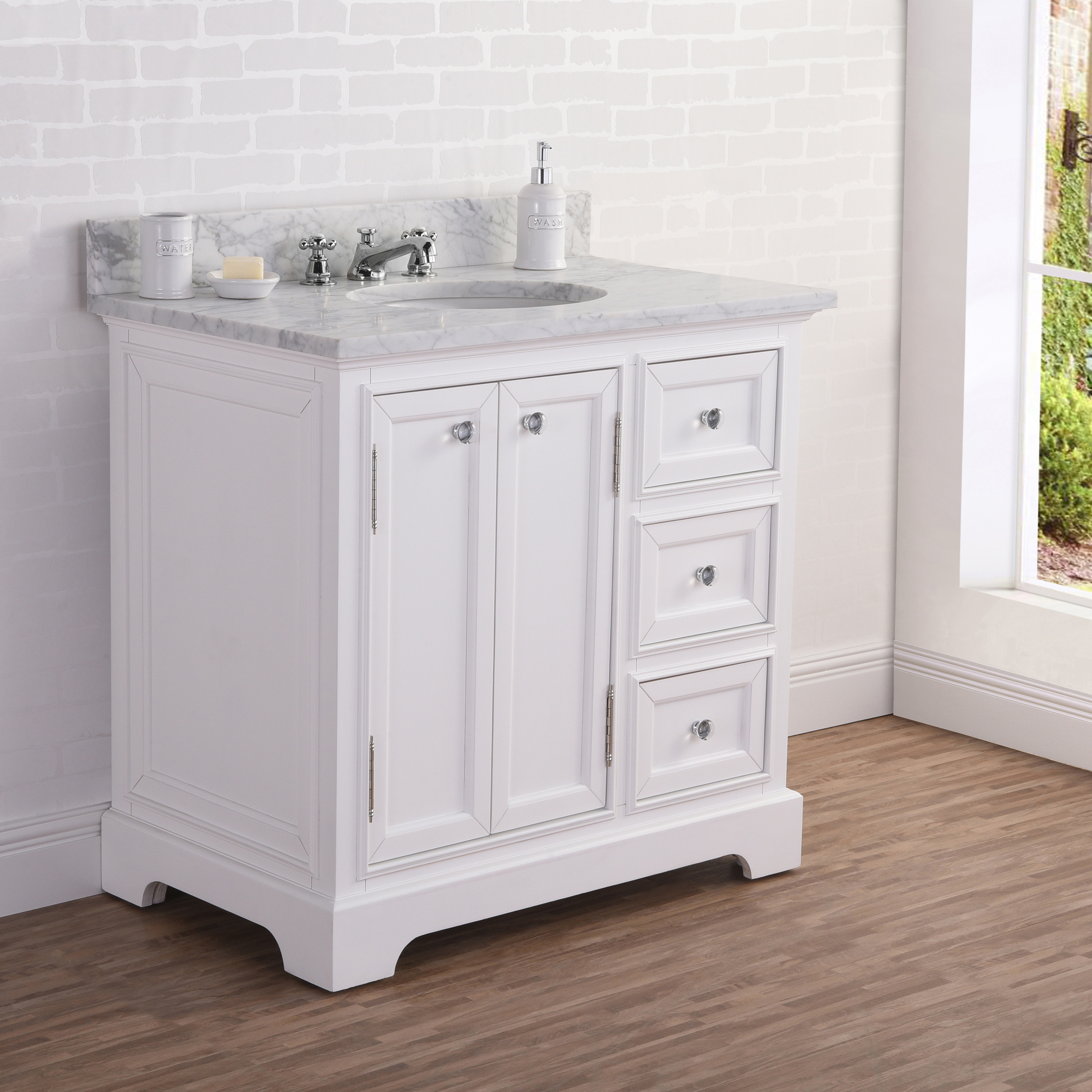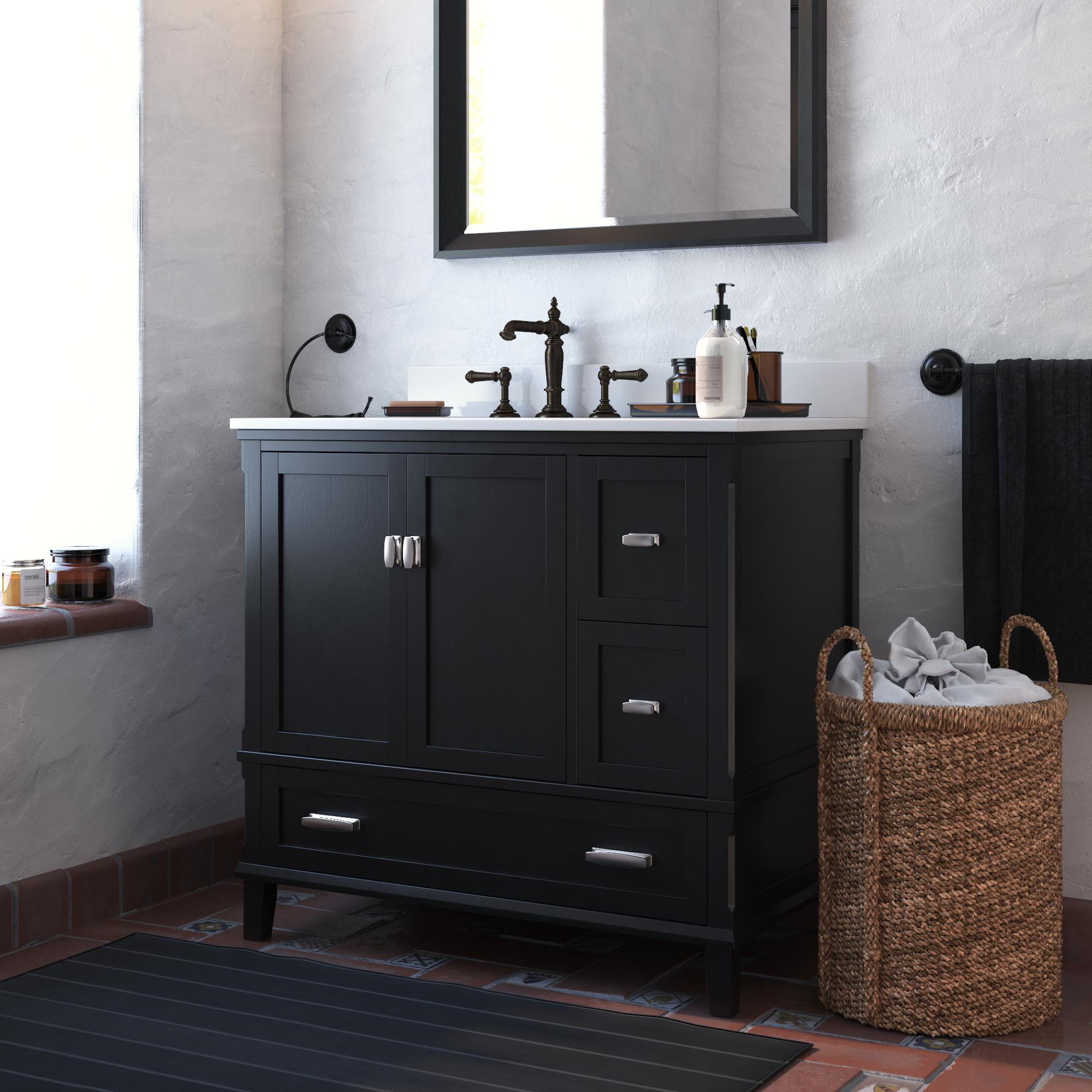The Allure of Antique Bathroom Vanities

Antique bathroom vanities possess a timeless charm that transcends mere functionality, offering a glimpse into the past and adding a touch of history to any modern bathroom. These exquisite pieces, often crafted with meticulous detail and enduring materials, speak to a bygone era of craftsmanship and design.
Historical Significance and Evolution, 36 inch antique bathroom vanity
The evolution of bathroom vanities mirrors the changing lifestyles and design trends throughout history. Early vanities, dating back to the Victorian era, were primarily functional pieces, often made of simple materials like wood and marble. As the 20th century progressed, vanities became more elaborate, reflecting the Art Deco and Mid-Century Modern movements.
Design Features and Craftsmanship
Antique bathroom vanities are characterized by their intricate details and exceptional craftsmanship. From hand-carved moldings and intricate inlays to ornate hardware and polished finishes, these pieces are testaments to the skill of bygone artisans. The use of traditional joinery techniques, such as dovetail joints and mortise and tenon construction, ensured the durability and longevity of these vanities.
Materials Used in Antique Vanities
Antique bathroom vanities were crafted from a variety of materials, each contributing to their unique character and aesthetic appeal.
Wood Types
- Oak: Known for its durability and rich grain patterns, oak was a popular choice for antique vanities. It was often used for both the vanity base and the countertop.
- Mahogany: Prized for its warm reddish-brown hue and elegant grain, mahogany was often used for vanity bases and decorative elements.
- Cherry: This wood is known for its rich reddish-brown color and beautiful grain patterns. It was often used for vanity bases and drawer fronts.
- Walnut: This wood is known for its rich, dark brown color and beautiful grain patterns. It was often used for vanity bases and drawer fronts.
Hardware
- Brass: Brass hardware was commonly used on antique vanities, adding a touch of elegance and durability.
- Bronze: Bronze hardware was also popular, offering a more rustic and aged appearance.
- Pewter: Pewter hardware was used for a more understated and refined look.
Finishes
- Polished: Polished finishes were common, enhancing the natural beauty of the wood and creating a lustrous sheen.
- Stained: Staining was used to accentuate the grain patterns and add depth to the wood.
- Painted: Painted finishes were also used, often in vibrant colors or distressed finishes to create a unique and antique look.
Popular Antique Vanity Styles
Antique bathroom vanities come in a wide array of styles, each reflecting the design trends of their respective eras.
Victorian
Victorian vanities are known for their ornate details, including intricate carvings, elaborate moldings, and decorative hardware. They often feature a dark wood finish and a countertop made of marble or granite.
Art Deco
Art Deco vanities are characterized by their geometric shapes, sleek lines, and bold colors. They often feature metal accents, such as chrome or nickel, and a countertop made of black or white marble.
Mid-Century Modern
Mid-Century Modern vanities are known for their clean lines, simple forms, and natural materials. They often feature wood veneers, minimalist hardware, and a countertop made of laminate or solid surface.
Finding the Perfect 36-Inch Antique Vanity: 36 Inch Antique Bathroom Vanity

Embarking on the quest for a 36-inch antique bathroom vanity is a journey of discovery, where history, craftsmanship, and personal style intertwine. This guide will equip you with the knowledge to navigate the world of antique vanities, ensuring you find the perfect piece for your bathroom oasis.
Sourcing Antique Bathroom Vanities
Finding a 36-inch antique vanity requires exploring various avenues. Antique shops, online marketplaces, and auction houses each offer unique opportunities to unearth treasures.
- Antique shops are a haven for vintage finds, often housing curated collections of antique furniture. Browse their inventory, engage with knowledgeable staff, and immerse yourself in the charm of these establishments.
- Online marketplaces like eBay and Etsy offer a vast selection of antique vanities, allowing you to compare prices, styles, and conditions from the comfort of your home. Use filters and search terms to narrow your search and discover hidden gems.
- Auction houses, both online and physical, provide a platform for bidding on antique vanities, often featuring rare and unique pieces. Research auction catalogs, set your budget, and participate in bidding wars for a chance to secure a coveted vanity.
Factors to Consider When Choosing a 36-Inch Antique Vanity
Selecting the right antique vanity involves a thoughtful assessment of style, condition, functionality, and budget.
- Style: Antique vanities come in various styles, from Victorian and Edwardian to Art Deco and Mid-Century Modern. Consider the overall aesthetic of your bathroom and choose a vanity that complements the existing decor.
- Condition: The condition of an antique vanity is crucial. Inspect for signs of wear and tear, including scratches, dents, and water damage. Evaluate the functionality of drawers, doors, and hardware. Authenticating the vanity’s age and origin can also be helpful.
- Functionality: Assess the vanity’s storage space, sink size, and countertop material. Ensure it meets your needs and provides adequate functionality for your bathroom.
- Budget: Antique vanities vary in price depending on their age, condition, and rarity. Set a realistic budget and be prepared to negotiate with sellers.
Authenticating Antique Vanities
Authenticating an antique vanity involves examining its construction, materials, and markings. Look for:
- Construction: Antique vanities were often crafted using traditional joinery techniques, such as dovetail joints and mortise and tenon construction. Examine the joinery for signs of craftsmanship and quality.
- Materials: Antique vanities were typically made from solid wood, such as oak, mahogany, or walnut. Look for the grain pattern, color, and texture of the wood. Check for signs of age, such as patina and wear.
- Markings: Some antique vanities may have maker’s marks, labels, or stamps. Research these markings to verify the vanity’s origin and age. Consult with antique experts or appraisers for assistance.
Recognizing Signs of Restoration or Reproduction
While some restoration is acceptable to preserve an antique vanity, be aware of signs that indicate excessive or inappropriate restoration or reproduction. Look for:
- Unnatural finishes: If the finish appears too perfect or glossy, it may be a sign of recent restoration or reproduction. Antique finishes tend to have a patina and wear that reflects their age.
- Modern hardware: Modern hardware on an antique vanity can be a red flag. Original hardware often has unique designs and materials that reflect the era of the vanity.
- Inconsistent construction: If the construction techniques or materials seem inconsistent with the age and style of the vanity, it may be a reproduction. Examine the joinery, wood grain, and overall construction for any discrepancies.
Restoring and Preserving an Antique Vanity
Restoring and preserving an antique vanity requires specialized knowledge and care. Consider the following steps:
- Cleaning: Start by gently cleaning the vanity with a soft cloth and mild soap. Avoid harsh chemicals or abrasive cleaners that could damage the finish.
- Repairing: Address any minor repairs, such as fixing loose hardware or patching small scratches. Consult with a professional restorer for major repairs.
- Finishing: If necessary, refinish the vanity with a compatible product that complements its age and style. Use a professional restorer to ensure the finish is appropriate for the vanity’s materials.
- Protection: Protect the vanity from moisture and scratches. Apply a sealant or wax to help preserve its finish. Consider using coasters and placemats to protect the countertop.
Integrating a 36-Inch Antique Vanity into Your Bathroom Design

The charm of an antique vanity lies not only in its timeless beauty but also in its ability to transform a bathroom into a sanctuary of elegance and history. A 36-inch antique vanity, with its compact size, offers a unique opportunity to create a bathroom space that is both functional and aesthetically pleasing. This section delves into the art of seamlessly integrating a 36-inch antique vanity into your bathroom design, considering its dimensions, style, and the overall aesthetic you envision.
Bathroom Layout Considerations
The key to successfully incorporating a 36-inch antique vanity lies in a well-thought-out bathroom layout. The vanity’s compact dimensions necessitate a strategic approach to maximize space and ensure functionality.
- Placement: A 36-inch vanity can be placed strategically in a corner, against a wall, or as a central focal point, depending on the bathroom’s size and layout.
- Traffic Flow: Ensure adequate space for movement around the vanity, allowing for easy access to the sink and storage.
- Storage Solutions: Utilize the space around the vanity to maximize storage, considering options like floating shelves, wall-mounted cabinets, or a small linen tower.
Complementing the Antique Vanity with Other Bathroom Fixtures
The beauty of an antique vanity shines when it is harmoniously complemented by other bathroom fixtures and decor.
- Faucets: Choose faucets that complement the vanity’s style. For a traditional look, consider antique brass or nickel faucets with intricate details. For a more modern twist, opt for sleek, minimalist faucets in brushed nickel or chrome.
- Mirrors: Mirrors play a crucial role in enhancing the ambiance and functionality of a bathroom. An antique vanity can be paired with a vintage-inspired mirror with an ornate frame, a simple rectangular mirror for a modern touch, or a unique, oversized mirror to create a statement piece.
- Lighting: Lighting is key to highlighting the beauty of an antique vanity. Consider installing sconces flanking the mirror for a classic look, or a pendant light above the vanity for a more contemporary feel. Ensure adequate lighting for both functional and aesthetic purposes.
Color Palettes and Design Schemes
The color palette and design scheme you choose can dramatically enhance the beauty of an antique vanity.
- Classic Elegance: A traditional bathroom with an antique vanity can be enhanced with a palette of warm neutrals like cream, ivory, and soft grey. Incorporate elements of gold, brass, or copper to add a touch of luxury.
- Modern Farmhouse: For a contemporary twist, pair an antique vanity with a modern farmhouse aesthetic. Utilize a neutral palette of white, grey, and black, accented with natural wood elements and rustic textures.
- Coastal Chic: Create a serene coastal bathroom by pairing an antique vanity with a palette of soft blues, greens, and whites. Incorporate natural materials like driftwood, shells, and rope to enhance the seaside ambiance.
Incorporating Modern Elements
While the antique vanity adds a touch of vintage charm, incorporating modern elements can create a balanced and stylish space.
- Geometric Tiles: Modernize the bathroom with geometric tiles in a contrasting color to the vanity.
- Minimalist Accessories: Keep accessories simple and functional, opting for modern towel bars, soap dispensers, and toothbrush holders.
- Statement Artwork: Add a touch of contemporary art to the bathroom with a bold print or abstract painting.
